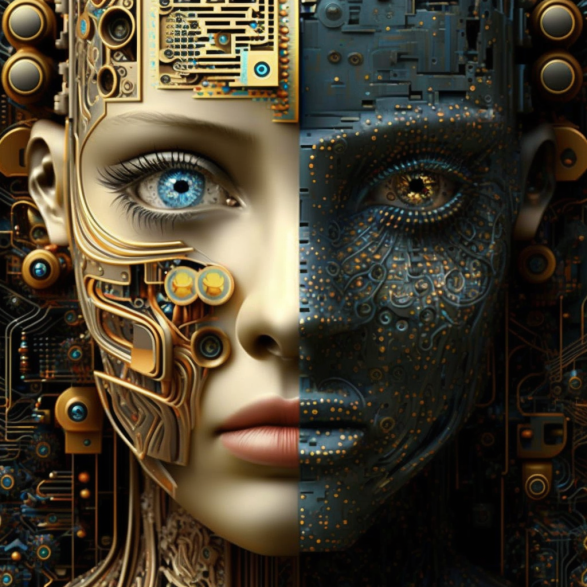I. Introduction
Machine learning has rapidly become an essential tool in solving problems and unlocking insights in a variety of industries, from finance to healthcare to transportation. At its core, machine learning is the process of teaching computers to learn from data, allowing them to identify patterns and make predictions on their own.
There are two main approaches to machine learning: deterministic and stochastic. Deterministic algorithms use a set of rules and logic to make predictions, while stochastic algorithms use probability and randomness to make predictions. In this blog, we will explore the differences between deterministic and stochastic approaches to machine learning, as well as the strengths and limitations of each approach.
II. Deterministic Machine Learning
Deterministic machine learning involves creating a set of rules that are used to make predictions. For example, a decision tree algorithm might create a tree-like structure of “if-then” rules based on past data. When presented with new data, the algorithm follows the rules to make a prediction.
One of the strengths of deterministic machine learning is that it is often easier to interpret and understand how the algorithm is making its predictions. Deterministic algorithms can also be faster and more efficient than stochastic algorithms, making them a good choice for large datasets.
However, deterministic algorithms can struggle with complex, nonlinear relationships in the data. If the data does not follow a clear set of rules, a deterministic algorithm may not be able to make accurate predictions. Additionally, deterministic algorithms may not be able to adapt well to changing data, as the rules are fixed.
III. Stochastic Machine Learning
Stochastic machine learning involves using probability and randomness to make predictions. For example, a neural network algorithm might use random weights and biases to make predictions based on past data. When presented with new data, the algorithm adjusts its weights and biases based on the outcome, improving its accuracy over time.
One of the strengths of stochastic machine learning is that it can handle complex, nonlinear relationships in the data. Stochastic algorithms can also adapt well to changing data, making them a good choice for dynamic environments.
However, stochastic algorithms can be slower and more computationally expensive than deterministic algorithms. They can also be more difficult to interpret, as the rules for making predictions are not always clear.
IV. Comparing Deterministic and Stochastic Approaches
Deterministic and stochastic approaches to machine learning have different strengths and limitations, making each approach more suitable for certain use cases. Deterministic algorithms are often best suited for problems where the relationship between inputs and outputs is well-understood and where speed and efficiency are important. Stochastic algorithms are often best suited for problems where the relationship between inputs and outputs is complex and nonlinear, and where accuracy is more important than speed.
One way to think about the trade-off between deterministic and stochastic approaches is to consider the bias-variance trade-off. Deterministic algorithms have low variance but can have high bias, meaning that they may be accurate on average but not necessarily for every individual prediction. Stochastic algorithms have higher variance but can have lower bias, meaning that they are more likely to make accurate predictions for individual cases but may have a higher error rate on average.
V. Reinforcement Learning
Reinforcement learning is a type of machine learning that combines both deterministic and stochastic approaches. Reinforcement learning involves an agent that interacts with an environment and learns to maximize a reward signal by taking actions that lead to the best outcomes.
Reinforcement learning algorithms use a deterministic approach to define the problem and a stochastic approach to explore the solution space. The algorithm learns from trial and error, adjusting its approach based on the outcomes of its actions.
Reinforcement learning has been used in a variety of applications, from training robots to play games to optimizing supply chain logistics.
VI. The Role of Deep Learning
Deep learning is a subset of machine learning that uses neural networks to learn from data. Deep learning algorithms can handle complex, high-dimensional data, making them a good choice for image recognition, speech recognition, and natural language processing.
Deep learning algorithms can use either deterministic or stochastic approaches, depending on the task at hand. For example, a convolutional neural network might use deterministic pooling layers to reduce the dimensionality of an image, while using stochastic dropout layers to prevent overfitting.
One of the limitations of deep learning is that it can require large amounts of data and computational power to train effectively. However, deep learning has shown promising results in a variety of applications and is an area of active research and development.
VII. Conclusion
Deterministic and stochastic approaches to machine learning have different strengths and limitations, making each approach more suitable for certain use cases. Deterministic algorithms are often best suited for problems where the relationship between inputs and outputs is well-understood and where speed and efficiency are important. Stochastic algorithms are often best suited for problems where the relationship between inputs and outputs is complex and nonlinear, and where accuracy is more important than speed.
Reinforcement learning combines both deterministic and stochastic approaches, making it a powerful tool for a variety of applications. Deep learning, a subset of machine learning that uses neural networks, can handle complex, high-dimensional data and has shown promising results in a variety of applications.
As machine learning continues to advance and become more ubiquitous, understanding the strengths and limitations of different approaches will be increasingly important in selecting the best approach for a given problem.









